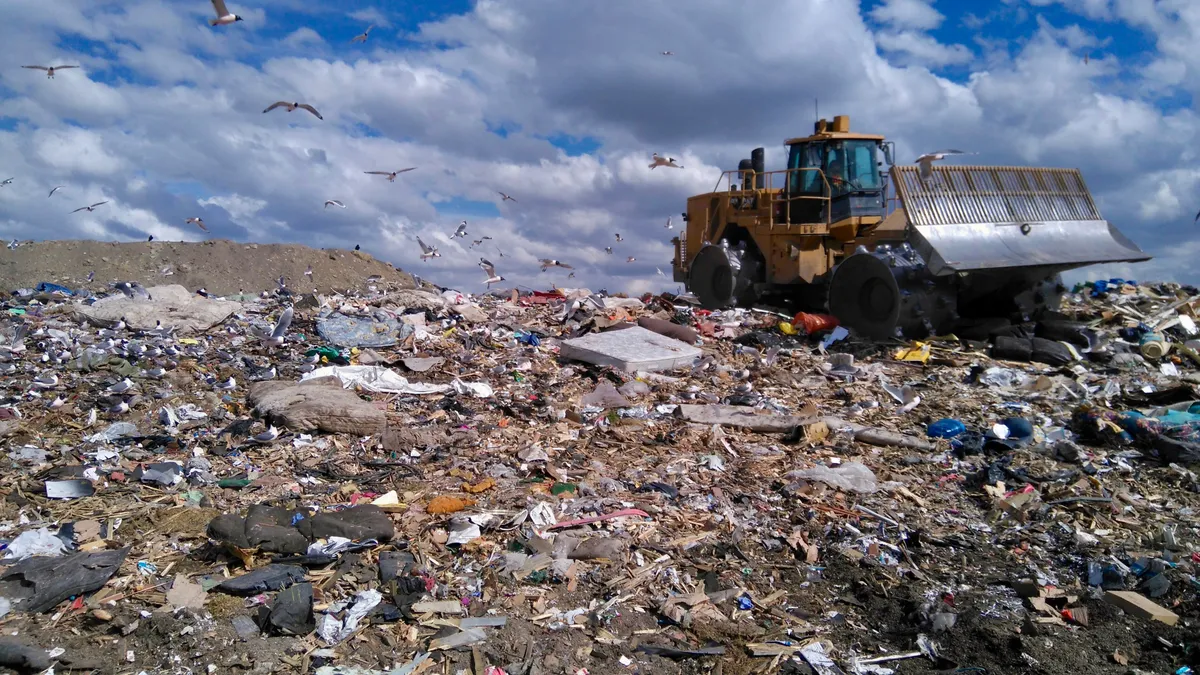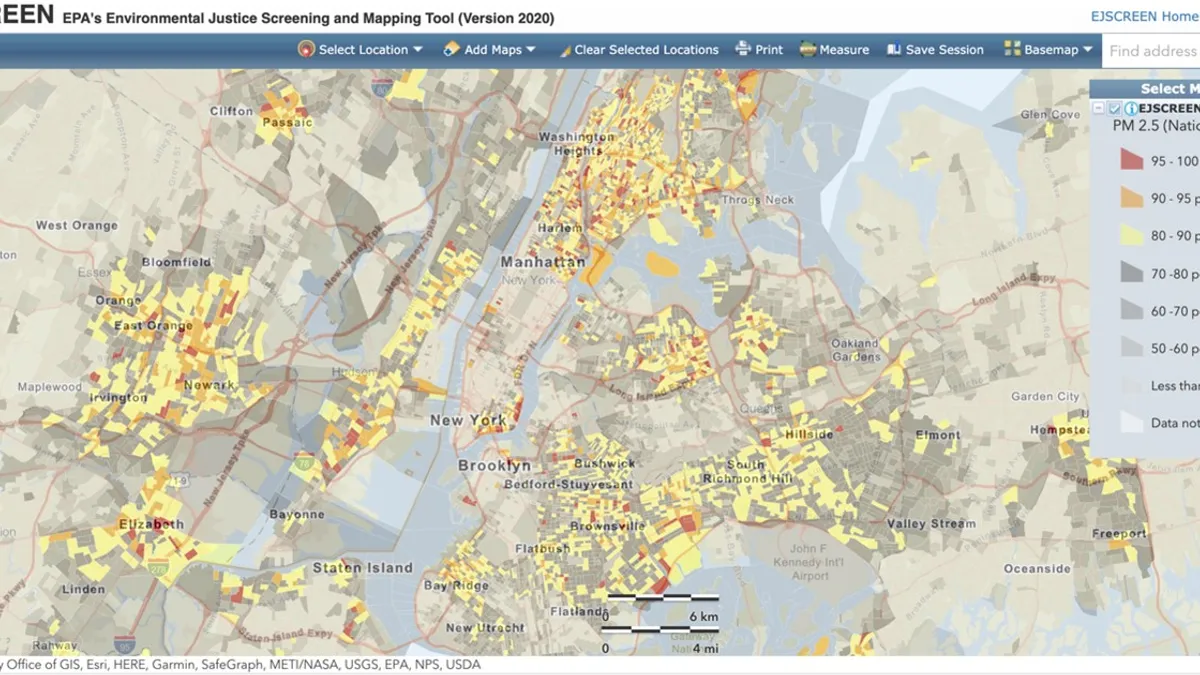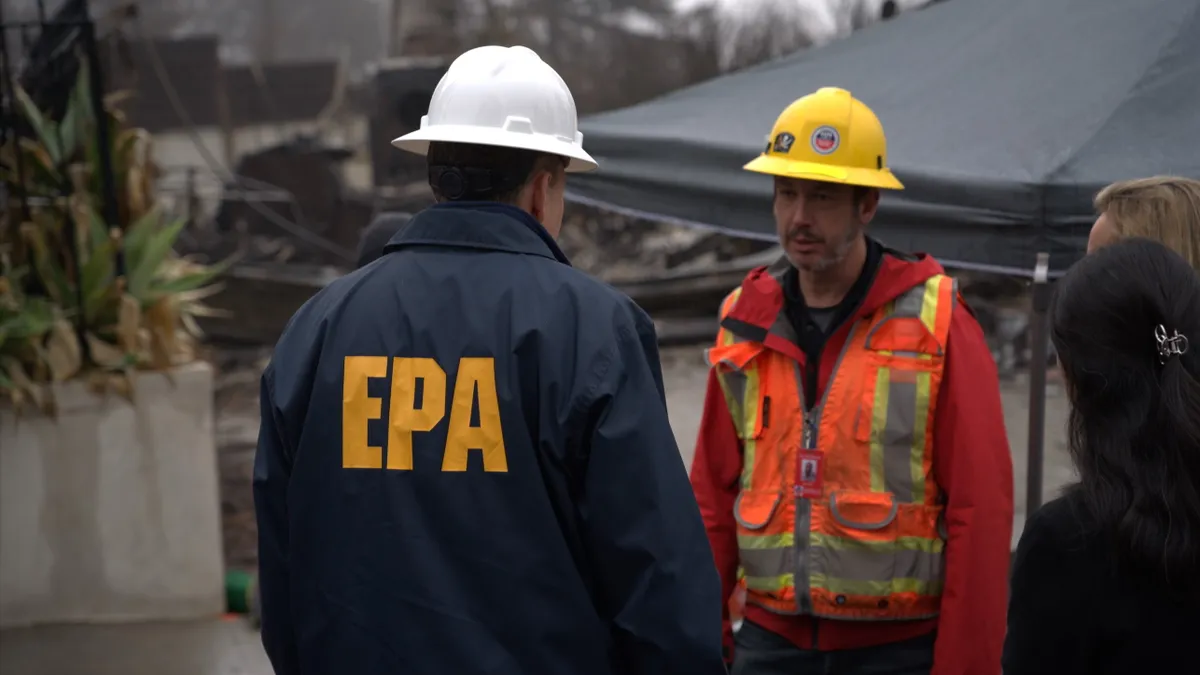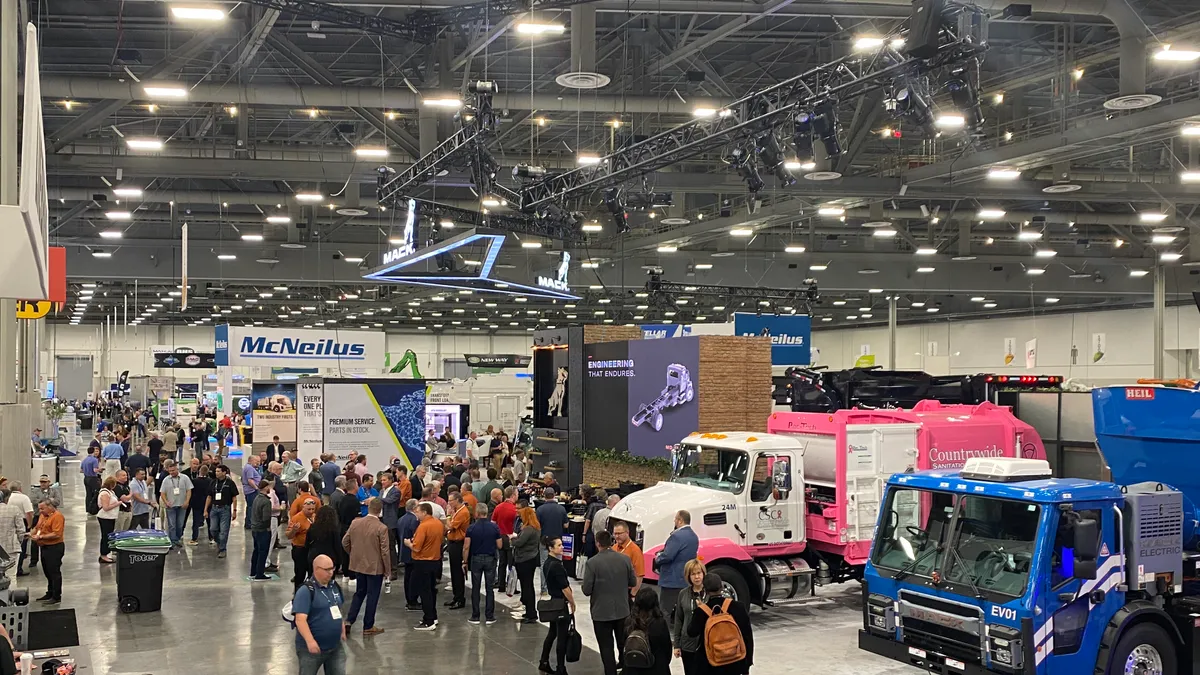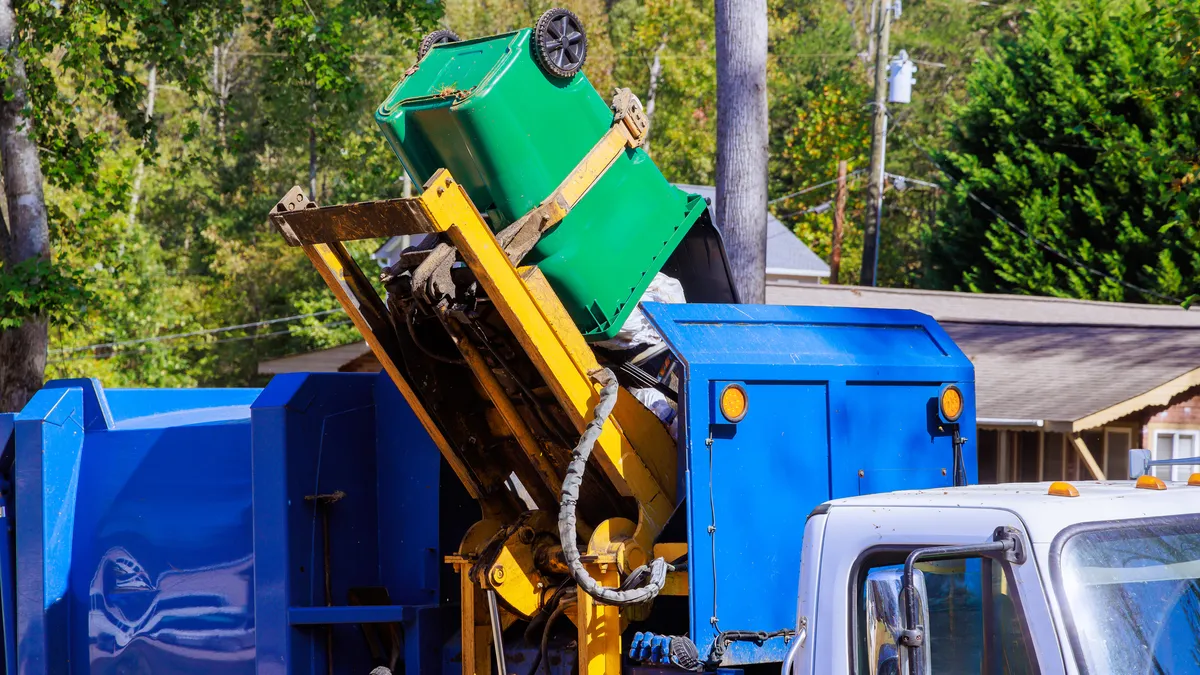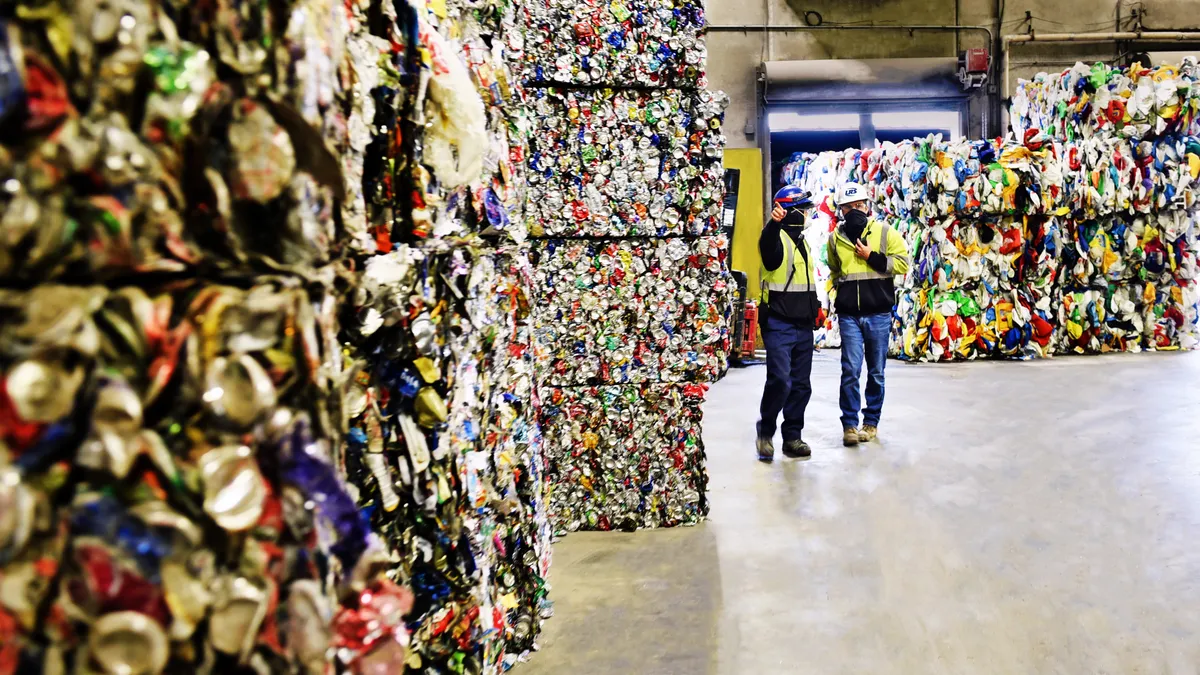Waste companies have long been comfortable dealing with regulations about tracking and reducing greenhouse gas emissions, but heightened attention may make that more complex in the years ahead.
The pressure to address contributions to climate change is starting to come from new sources. Growing numbers of customers and investors are insisting that all industries — waste included — record greenhouse gas emissions and shrink their carbon footprints. In a relatively short period, considering how a company may be exacerbating the effects of climate change morphed from a peripheral concern for investors to a mainstream inquiry.
“I continue to be impressed by how quickly this conversation has changed, and how rapidly it's evolved in the last few years,” said Hana Vizcarra, a staff attorney at Harvard Law School’s Environmental & Energy Law Program.
In January, for example, the chief of the investment group BlackRock, which has holdings in several major waste companies, wrote a letter to CEOs urging them to bring their net emissions to zero by 2050. In many cases that objective would be more aggressive than the climate targets set by the industry’s largest companies. The request comes with force, as the firm has begun to hold companies accountable for their climate-related choices.
The financial group’s announcement happened within a week of the inauguration of U.S. President Joe Biden, who leads an administration that has promised stronger action on climate change and emissions reduction measures – including a focus on methane. Any actions making good on the promises could potentially include actions affecting landfills. All together, the facilities accounted for 17.3% of human-caused methane emissions in the U.S. in 2019, and clocked in as the third largest source of the gas, according to the latest emission data released by the U.S. EPA.
Even if advocates for emission transparency and reduction aren’t talking specifically about landfills yet, those are the facilities waste companies will have to address most directly to meaningfully lower emissions.
In 2019, landfills accounted for over seven times as much emissions as Waste Management’s energy-related and vehicle-related emissions combined, a ratio Republic Services mirrored in the same year. As an entire industry, landfills produced 114 million metric tons of carbon dioxide equivalent greenhouse gases that year, per the latest EPA data.
For landfill operators working to report emissions, the agency has a process overflowing with calculation methods and nuanced approaches to what happens to buried piles of waste. And that complexity is only about reporting landfill emissions. Deciding how to reduce them is similarly complicated.
Complex calculations
The idea that landfills produce greenhouse gases — and companies might have to report them — has been a known reality for years. When trash is packed into a pile, the oxygen-free environment supports bacteria that thrive in those conditions. As the microbes degrade the waste, they release carbon dioxide and methane. The latter is, depending on what timeframe you look at, 84 times more potent of a global warming agent than carbon dioxide in the first 20 years of its release or 25 times more potent within a century.
Some landfills put out more methane than others, depending on the facility’s age, size and whether it has gas capture systems installed. Roughly 1,500 landfills are what the EPA calls “large emitting facilities” that need to report their emissions to the agency every year via a dedicated, federal formula. Landfills in this EPA program are the only ones required by federal law to follow this given formula to do the emission math.
In California, some facilities might also be required to report emissions through a calculator developed by the California Air Resources Board (CARB). Otherwise, landfill operators also have a suite of different formulas available to assess greenhouse gas levels coming from their sites.
Basically, each calculator “uses about the same equation,” said Florentino De la Cruz, a Research Scientist at the Department of Civil, Construction and Environmental Engineering at North Carolina State University. “The only difference is: What are the input parameters?”
The core calculation plays out like this: Landfill operators first model the amount of methane their waste generates and then subtract how much gas doesn’t actually reach the atmosphere, either because the company siphons it off or because the gas transforms into carbon dioxide by passing through the landfill cover. Where the calculators differ is in the assumptions each makes about how waste (and landfills) behave. These default values explain in part why the final methane emission value depends on the calculator.
The original method is the Intergovernmental Panel on Climate Change (IPCC) inventory. Those who use it can provide specific, customized data about their facilities — which companies or local governments can often get if they fund the examinations needed to collect it. While there’s some data gathering requirements, if operators want to work with any custom information beyond what’s mandated, “it’s really up to your own willingness to pay,” said Eugene Mohareb, a lecturer in sustainable urban systems at the University of Reading in the U.K.
For example, the IPCC protocol lets landfill operators approximate how much methane filtering through the top of their sites turns into carbon dioxide. The less methane emitted the better, so this is a desirable conversion process, Mohareb said.
If an operator doesn’t have a personal, evidence-based estimate, it would use the default methane conversion values in the system. The IPCC default conversion rate is 10%. However, several studies have shown that the rate lies somewhere between 10% and about 37%, depending on humidity and other environmental conditions around the landfill, and Mohareb added that even less than 10% could be converted at a given site, too.
Other calculators allow flexible data input in different parts of the equation. One option, the Solid Waste Industry for Climate Solutions (SWICS) calculator, was first proposed by several waste companies and a team of academic advisors in 2007.
The designers offered the methodology as an alternative to the CARB calculator and it has since been partially incorporated into the EPA protocol some landfills are mandated to follow. For some users, SWICS inverts the calculation process. Other calculators have landfill operators first model how much gas their trash releases. SWICS says that if a facility has gas collection technology, operators start with how much gas they trap, follow a protocol to calculate collection efficiency, and arrive at how much gas their trash produces and emits.
SWICS also lets landfill operators credit methane capture technologies for being better at their job than other optional calculators do. Landfill gas capture systems always have leaks and imperfections, and some accounting methods assume the gear can only trap a fixed percentage of the methane, such as 75%. SWICS allows waste companies to use collection efficiency between 50% and 99%.
This approach more accurately reflects specific site conditions and today’s technology while allowing operations to show improvement, said Pat Sullivan, a senior vice president with SCS Engineers, an environmental engineering and consulting firm. “The full SWICS method gives you that ability to demonstrate improvements,” said Sullivan. A system doing a poor job collecting gas would get a low percentage, “but if I make a major improvement, and I prove that,” he said, “well then, you can show an increased value.”
One of the most customizable calculators also comes from the EPA: the Waste Reduction Model (WARM). This program lets users get specific about the kind of waste they handle — including the kinds of metals, plastics and even meat varieties collected. For comparison, the IPCC calculator is considered accommodating by having eight waste categories by which operators can define their landfill input, each with their own assigned emission rate.
However, WARM is not supposed to be used to calculate what emissions a given landfill generates, according to the EPA. And despite waste type flexibility, WARM also offers only relatively rigid values for gas collection efficiency and methane conversion rates. Instead, WARM factors in recycling, composting and other waste management practices so users build a holistic view of all the ways they generate greenhouse gases or prevent them.
“It’s a great planning tool and I haven’t seen anything comparable in the U.K. or Europe more widely,” Mohareb said.
Once a company calculates its landfill or other operational greenhouse gases, the final report might set aside a “biogenic emissions” category. This separate designation in the document includes the carbon dioxide coming from wood, paper, food and other organic matter.
Scientists generally think carbon dioxide from these items doesn’t contribute to climate change. When plants grow and store carbon dioxide and then human waste releases the gas from those sources back into the atmosphere, there’s no overall increase in how much of the molecule is circulating, said De la Cruz. “It is essentially putting back what's already there.”
Since greenhouse gas inventories reflect how a facility contributes to climate change, most major landfill companies don’t include biogenic carbon dioxide as part of their official tally and put the values in a separate line item.
Some researchers are now countering the idea that biogenic carbon is consequence-free. Since the gas often enters the atmosphere in concentrated bursts, the researchers argue, it likely lingers for years before growing plants remove it from the air, allowing the greenhouse gas to contribute to global warming.
Despite the time and attention given to these complex emission calculators, research groups are also developing tools that could eliminate modeling-based estimates altogether. Several years ago, a NASA research group relied on drones and satellites carrying methane-detection technology to read where in California the greenhouse gas was coming from and how much each source was putting out. The survey, published in 2019, found that 55 “super-emitters” were generating a third of the state’s methane budget — and several of the responsible operations were landfills.
Since then, more groups have begun developing direct measurement devices. Waste Management mentioned pursuing the technology in its 2020 sustainability report. Groups like the Environmental Research & Education Foundation (EREF), a research organization funded in part by the industry, have joined the research effort, too. The assumption is this approach has the potential to be more accurate than currently available methane calculators, said Bryan Staley, the president and CEO of EREF.
“If I'm filling up my bathtub and I left the water on, what's going to be more accurate? For me to be downstairs and say, well, it was roughly three gallons a minute, I got a 10 gallon tub, so it's going to take me about two-and-a-half minutes to fill up? Or is it better just to go upstairs and take a look?” he asked.
The technology might be prohibitively expensive for many landfill operators for a while, particularly if it exists only in fly-over or satellite devices. The measurement technique could also need extra calculations or repeat fly-overs, since daily wind speed or temperatures can change what a reading picks up. But ultimately, “as more capabilities are brought online, that should drive the cost down to be able to do these measurements more easily,” Staley said. “This is all happening in real time, as we speak, over the next few years.”
Evolving regulations
As methane measurement technologies get more precise, so do the legal requirements around what to do about the underlying emissions.
In 2016, for example, the EPA announced updated rules about existing and new landfills. The agency was going to lower the emissions threshold at which landfill operators are required to install gas control and mitigation equipment, a change that would impact over 1,900 facilities. States would have to submit individual plans on how to implement these measures to the EPA for approval. If the state couldn’t provide a protocol the agency liked, the EPA would provide a framework.
Under the Trump administration the rules sat in a kind of purgatory, with the EPA delaying action and lawsuits pushing for progress, Vizcarra said. But President Biden on his first day in office signed an executive order pushing the EPA to look at moving forward on the program. The agency has announced its intention to issue state plan guidance in May.
While it’s hard to compare how the new EPA leadership may scrutinize state plans, because the Trump administration addressed so few of them, Vizcarra said, “[the Biden administration is] likely to take a sharper look at whether the plans are capable of achieving the standards that were set.”
To comply with the new standards, U.S. facilities have a range of emission-reduction strategies to choose from or advocate for. In the European Union, waste companies had their tactics chosen for them — put less trash in landfills, period. In 2018, the organization finalized new waste reduction and circular economy goals. The block wants member nations to recycle 70% of packaging waste by 2030 and 65% of municipal waste by 2035. These are desired outcomes, but one change is required: Members will funnel no more than 10% of municipal waste to landfills by 2035.
The EU’s waste hierarchy plan, which has been in place since 2008, explains in part the push to essentially abandon landfill growth. Preventing waste is the best choice in the protocol, the second-worst option is “recovery,” and the last-resort treatment method is disposal.
While the U.S. has a similar recommended hierarchy, EU waste reduction and circular economy goals are legally binding. Occasionally, incineration is preferable to landfilling: If the facility produces enough energy, it contributes to the “recovery” system, though Ballinger says most incinerators don’t produce enough power to outrank disposal.
“Historically, you had a landfill directive which enforced certain practices as far as landfill waste management is concerned, but also was instrumental in driving residual waste away from landfill and towards incineration,” said Ann Ballinger, a principal consultant with Eunomia, an environmental consulting agency based in the U.K.
Incineration still produces carbon dioxide and relies on landfills — about 2% of the original waste volume qualifies as a particularly toxic ash that needs specialized disposal sites, while another 25% turns into ash that can be landfilled or used as a recycled aggregate. However, the final volume of waste is significantly smaller and the combustion process makes heat, which can be turned into electricity.
Enthusiasm for incineration’s potential role amid growing climate focus has spread to waste companies operating in the U.S. For example, Covanta – the national industry’s largest incinerator operator – anticipates incineration could play a greater role depending on the evolution of emissions regulations. Part of the appeal, in the company’s view, lies in the possibility that one day companies could capture carbon dioxide from the process and funnel it away as part of a carbon storage program.
“We have also begun tracking the development of carbon capture and sequestration technologies that can be deployed at [waste-to-energy] facilities over the long-term,” Covanta noted in one of its climate impact reports. Ramping up storage abilities also has Covanta and other waste companies thinking about becoming carbon negative — operations that prevent more greenhouse gas from entering the atmosphere than they emit. As Mike Van Brunt, senior director of sustainability at Covanta said last year, “you can't apply that kind of a technology to a landfill.”
If carbon capture and sequestration eventually became a viable technology for landfills, operators are interested in pursuing tax credits for that added storage. Right now, landfills naturally do some carbon storage, albeit on a smaller scale. Trash buried in landfill piles only degrades part of the way. Whatever carbon sticks around and isn’t released as a gas, De la Cruz said, is stored and won’t re-enter the atmosphere or the above-ground pool of circulating carbon.
Each landfill emission calculator handles the inherent carbon storage differently. SWICS lets users calculate it and treats the value as a kind of side detail. Companies can share it in their reports but the number isn’t subtracted off their overall emissions, Sullivan said.
An EPA program accounts for the sequestered carbon in landfills too, but the agency conducts a nationwide tally; individual landfills don’t report their own values. The IPCC inventory, which includes new information from De la Cruz’s research, lets companies calculate stored carbon as a side value, too. Natural landfill carbon storage hinges on decay rates, which vary based on temperature and moisture levels, as well as what kind of trash gets preserved.
While landfill operators can tweak and fine-tune assessments of natural carbon storage, the facilities don’t have precise ways to change decay conditions and ramp up how much carbon is sequestered this way, De la Cruz said. Only operations that inject gas into the ground could drastically increase the storage levels.
As for pursuing gas collection and injection facilities attached to incinerators, Ballinger suggests some caution about that approach. The technologies that would be involved aren’t widely available and probably won’t be for a number of years. Additionally, a carbon capture and storage system attached to an incinerator should still be accompanied by higher recycling rates. Combusting the oil and petroleum-based products would mean no emission-reduction benefits of using recycled plastics over virgin ones, Ballinger said. Right now, Ballinger and her colleagues advocate to boost recycling levels and downstream markets — and strive to extract as much plastic from incinerator-bound trucks as possible.
Accounting and accountability
Though detailed, backed by science and deliberately crafted, landfill emission calculators ultimately still produce estimates and not exact data.
“A lot of these inventory models that are being used by the regulatory agencies are really, at best, decent estimates at a regional level, and perhaps even better at a national level,” Staley said. “To apply them on a per-landfill basis — there are just too many assumptions built in.”
The range of potential final values the different inventory techniques might put out leaves room for debate, with waste companies often opting for the techniques they think are more accurate. Even though the EPA model contains parts of SWICS, for example, it still keeps fairly limited estimates of collection efficiency, which is why landfill operators might opt for SWICS when other reporting programs let them, Sullivan said.
A future where people can directly measure the gasses issuing from a facility suggests that emissions reporting could be more accurate — and transparent. EREF studies so far indicate that EPA calculating protocols might be overestimating landfill emissions, Staley said. While people could still share remote sensing results out-of-context and the technology would still need expert operators, “I think it adds a level of accountability when you do the direct measurements, absolutely,” he added. “Because anyone could do it.”
Of course, “accountability” is the broader demand that regulators, elected officials and investors have of waste companies. Financial groups, which may not have seen much backing by the former administration in their requests for more emissions-related information from the private sector, could be bolstered by the Biden administration: In February, the U.S. Securities and Exchange Commission announced it will review how companies disclose climate change-related risks.
State governments have started demanding disclosures, too. New York will require investor-owned utilities to disclose climate-related risks every year, and the California legislature introduced a bill this year that would require any company operating in the state and taking in $1 billion or more in revenue each year to make annual emissions disclosures and set science-based targets for reducing their carbon footprints.
Meanwhile, investors are continuing their march toward requiring more emissions data and other climate risk-related information from companies. These arguments that climate-related information is “legally material” — or crucial for investor decision-making — are gaining strength, Vizcarra said, and appear here to stay.
“The trend is already going in one direction, even without the regulatory push.”


